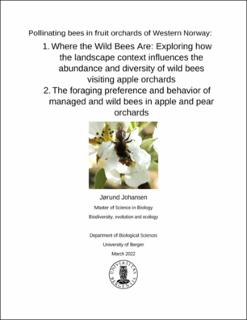| dc.description.abstract | 1) Abstract. Several studies have found that the presence of natural and semi-natural habitats is beneficial, particularly for wild bees visiting crops. These relatively undisturbed areas provide essential foraging and nesting opportunities for wild bees. However, the importance of these habitats seems to vary depending on the intensity of the agricultural activity in the area as well as the geographical and climactic regions being surveyed. In addition, the spatial scales at which different pollinator groups respond to the landscape context seems to be related to their respective foraging ranges. In Norway, the relationship between the landscape context and pollinator communities remains largely unexplored. Here, I provide evidence that semi-natural habitats increase the abundance and diversity of wild bees visiting apple orchards in Western Norway. Specifically, I found that the abundance and diversity solitary bees was related to the proportion of forest cover on the local scale (<500 m from orchards), while bumblebee abundance and richness was related to the proportion of pastures surrounding the orchards on scales from 500-2000 m. Even though my sample size was small, my findings indicate that natural and semi-natural habitats can enhance the wild bee abundance and richness in crop systems, even in the relatively heterogenous landscapes typically surrounding fruit orchards of Western Norway. 2) Abstract. Effective pollinators are essential for the sexual reproduction of many important crops, especially for fruit crops that require cross-pollination with compatible cultivars to bear optimal fruit. To ensure pollination, managed honeybees hives are often placed in fruit orchards, as honeybees are flower constant generalists that can effectively pollinate a wide variety of crops. However, wild pollinators can act as pollination insurance if honeybee colonies fail. In addition, many wild pollinators are more effective pollinators on a per visit basis. In Norway, the relative importance of different pollinator groups has received little attention. In this study I compared the visitation frequency and foraging behavior between managed honeybees and wild bees in two fruit orchards producing apple and pear fruit. I found that honeybees likely are the most important pollinators of pear flowers in the study area, due to their superior visitation frequency compared to wild bees. However, bumblebees may be more important for apple pollination as they were similar to honeybees in their visitation frequency to apple flowers. In addition, I found that bumblebees are faster foragers, due to their lower handling times and search times, enabling them to visit more flowers per foraging trip than honeybees, potentially moving more compatible pollen between flowers. | |
